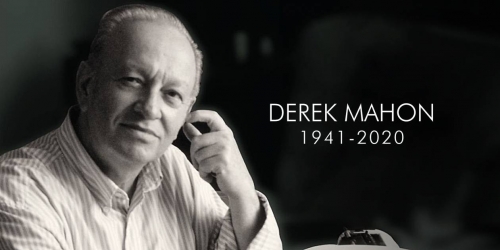Rathlin: In memory of Derek Mahon

Jenny Farrell memorialises Derek Mahon by presenting a reading of his poem Rathlin, bringing out its political message and artistic skill
Derek Mahon died on 1 October. Born into the Protestant Belfast working class, he was of a generation with Seamus Heaney and Michael Longley. All three poets benefitted from the Education Act (Northern Ireland) 1947, which allowed students who won scholarships to go on to secondary schools and from there to university. Both Mahon and Heaney chose not to live in the six counties for most of their adulthood, while the troubles nevertheless make themselves felt in their poetry.
Is there a better way to honour the life of an artist than to look at one of their works, which will capture their spirit, their person more accurately than any biography, and give access to their individual voice? And so, while there are many tributes to Mahon in the media at the moment, all outvying each other in honouring the non-political poet, we look at a poem that reveals what the poet felt about the violence of the English State in Ireland.
Rathlin
(published in The Hunt by Night, 1982)
The title of this poem refers to an island off the Antrim coast. It refers both to the nature reserve it is home to today as well as the scene of a terrible massacre in 1575, conducted by Elizabeth I’s marshal in Ireland, Essex, against a Scots-Irish chieftain. 500-600 people were murdered.
A long time since the last scream cut short –
Then an unnatural silence; and then
A natural silence, slowly broken
By the shearwater, by the sporadic
Conversation of crickets, the bleak
Reminder of a metaphysical wind.
Ages of this, till the report
Of an outboard motor at the pier
Fractures the dream-time, and we land
As if we were the first visitors here.
The poem’s opening lines refer to this massacre: it happened a long time ago, yet there is an immediacy about the last scream, which is underlined by the profusion of ‘S’ and ‘T’ sounds in the line. The unnatural silence still carries echoes of the screams; nature seems to have been shocked into stillness over this atrocity. A natural one – an absence of human habitation – follows the unnatural silence.
Seabird sounds and the occasional chirping of crickets break this silence. These sounds, belonging to the natural world, put the speaker in mind of a metaphysical wind, perhaps echoes of conversations past. These natural sounds dominate the island until now, when the ‘man-made’ sound of a motorboat Fractures this peace. The speaker, along with others, lands on the island as though they were the first humans to set foot here. They realise, of course, that they are not, and that a dark and terrible history haunts the apparent peace of this place.
The whole island a sanctuary where amazed
Oneiric species whistle and chatter,
Evacuating rock-face and cliff-top.
Cerulean distance, an oceanic haze –
Nothing but sea-smoke to the ice-cap
And the odd somnolent freighter.
Bombs doze in the housing estates
But here they are through with history –
Custodians of a lone light which repeats
One simple statement to the turbulent sea.
The middle stanza consists of three sentences. The first one, (lines 11-13) evokes the whole island as a wonderful nature sanctuary. Mahon uses Latin and Greek terms, creating a certain distance to the world of nature, as though a scientist or historian is looking at it: Oneiric (dream-like: links to ‘dream-time’ in stanza 1), or Evacuating. Evacuating hints at wartime and the present, or recent past. However, the image is alive with movement, sights and sounds.
The next sentence and image continues this use of Latin words in Cerulean (deep sky blue). Line 14 gives a wonderfully complex visual impression of the sky over the sea and the hazy line in between. This haziness is continued in the beautiful image of sea-smoke, and in line 16 there is the first suggestion of human presence, albeit quite peaceful and out at sea, the odd somnolent (sleepy, drowsy – links to links to ‘dream-time’ and ‘oneiric’) freighter.
Sleepiness of a different kind shocks the reader in the line that follows, practically in the middle, or heart, of the poem: Bombs doze in the housing estates. This clashes with everything about this island – except for its history. Through this apparently unrelated image, one could argue that Rathlin becomes a symbol for the North of Ireland at least, if not for the whole of Ireland, with its tremendous potential for natural beauty but also its history of violence.
Interestingly, this image of bombs in a housing estate, i.e. in cities, is simply left there and followed by the comment But here they are through with history. Pre-history as the time before humans recorded events, post-history as post-human? All human involvement with this island is the light-house: a lone light that repeats/ One simple statement to the turbulent sea.
What is this simple statement? The need for peace? The stanza’s concluding image seems to attribute a certain symbolism to the sea as a place of turmoil, rather like history – the tables seem to be turned here – the lighthouse gives guidance to nature: or symbolically, the inhabitants of the nature sanctuary provide light to a ‘sea of troubles’.
A long time since the unspeakable violence –
Since Somhairle Buí, powerless on the mainland,
Heard the screams of the Rathlin women
Borne to him, seconds after, upon the wind.
Only the cry of the shearwater
And the roar of the outboard motor
Disturb the singular peace. Spray-blind,
We leave here the infancy of the race,
Unsure among the pitching surfaces
Whether the future lies before us or behind.
The poem’s final stanza consists of three sentences, two distinct parts. The first part relates to the most harrowing moment of the massacre for Somhairle Buidh, hearing the screams of the victims, carried to him to the mainland by the wind with a slight delay. This delay is enacted magnificently in the line, which causes the reader – through caesura – to stop briefly: Borne to him, seconds after. This description is supremely poignant; an image that is hard to forget. The auditory (screams) and tactile (wind) qualities that go into this image intensify the sense of the powerless horror of this unspeakable violence. This vivid image also connects the past with the present – such terror of the victims and the horror of the powerless onlooker could apply to similar situations at any time or any place.
The next two lines contrast with this shocking image and draw the reader into the present, connecting with stanza 1: the sounds of the shearwater and the motorboat. However, these sounds here echo the slaughter – cry and roar, they cannot be evaded. This ambiguity is magnificently resolved in the conclusion of this sentence, in the middle of line 27: Disturb the singular peace. ‘Singular’ is ambiguous: referring to the exceptional, the nature sanctuary, a place outside of history, and the situation in the six counties at the time of the Troubles.
In the poem’s final image, the visitors to Rathlin leave the island in their boat; the infancy of the race could refer to animals – before humankind. Blinded by the spray, confused, unsure, on a turbulent sea, the pitching surfaces, as to Whether the future lies before us or behind. What is the future of the North of Ireland? Where will violence lead? Can there only be peace in a place empty of people, either before or after history? These are searching questions, to which recent history has provided an answer. The speaker in this poem, who sees himself on a turbulent sea, finds guidance in the simple statement provided by the custodians of Rathlin’s lighthouse.

Jenny Farrell
Jenny Farrell is a lecturer, writer and an Associate Editor of Culture Matters.
Latest from Jenny Farrell
- Poetry for the Many, an anthology by Jeremy Corbyn and Len McCluskey
- A hopeful vision of human renewal: the theatre of Seán O'Casey
- Art that's rooted in the upheavals of his time: Caspar David Friedrich, 1774-1840
- A Drive to Change the World: James Baldwin, Black Author, Socialist and Activist
- A woman's perspective on the invisible front: A review of 'The Shadow in the Shadow'
